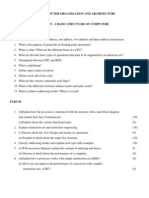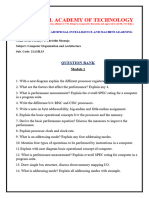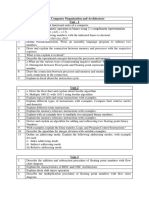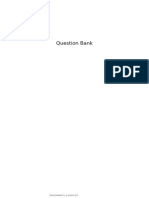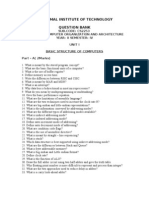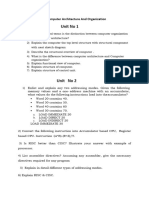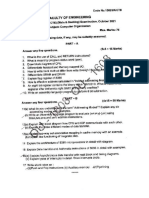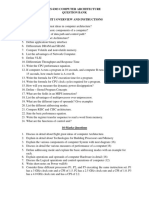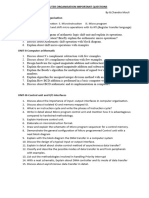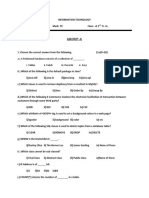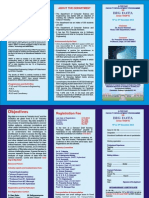0 ratings0% found this document useful (0 votes)
170 viewsCOA Question Bank
COA Question Bank
Uploaded by
WednesdayThis document contains a question bank for a Computer Science and Engineering course covering 10 units:
1) Computer Data Representation
2) Basic Computer Organization and Design
3) Assembly Language Programming
4) Micro-programmed Control Organization
5) Central Processing Unit
6) Pipeline & Vector Processing
7) Computer Arithmetic
8) Input-Output Organization
9) Memory Organization
10) Multiprocessors
The question bank contains multiple choice and descriptive questions to assess student understanding of key concepts in each unit.
Copyright:
© All Rights Reserved
Available Formats
Download as PDF, TXT or read online from Scribd
COA Question Bank
COA Question Bank
Uploaded by
Wednesday0 ratings0% found this document useful (0 votes)
170 views3 pagesThis document contains a question bank for a Computer Science and Engineering course covering 10 units:
1) Computer Data Representation
2) Basic Computer Organization and Design
3) Assembly Language Programming
4) Micro-programmed Control Organization
5) Central Processing Unit
6) Pipeline & Vector Processing
7) Computer Arithmetic
8) Input-Output Organization
9) Memory Organization
10) Multiprocessors
The question bank contains multiple choice and descriptive questions to assess student understanding of key concepts in each unit.
Original Title
COA Question bank
Copyright
© © All Rights Reserved
Available Formats
PDF, TXT or read online from Scribd
Share this document
Did you find this document useful?
Is this content inappropriate?
This document contains a question bank for a Computer Science and Engineering course covering 10 units:
1) Computer Data Representation
2) Basic Computer Organization and Design
3) Assembly Language Programming
4) Micro-programmed Control Organization
5) Central Processing Unit
6) Pipeline & Vector Processing
7) Computer Arithmetic
8) Input-Output Organization
9) Memory Organization
10) Multiprocessors
The question bank contains multiple choice and descriptive questions to assess student understanding of key concepts in each unit.
Copyright:
© All Rights Reserved
Available Formats
Download as PDF, TXT or read online from Scribd
Download as pdf or txt
0 ratings0% found this document useful (0 votes)
170 views3 pagesCOA Question Bank
COA Question Bank
Uploaded by
WednesdayThis document contains a question bank for a Computer Science and Engineering course covering 10 units:
1) Computer Data Representation
2) Basic Computer Organization and Design
3) Assembly Language Programming
4) Micro-programmed Control Organization
5) Central Processing Unit
6) Pipeline & Vector Processing
7) Computer Arithmetic
8) Input-Output Organization
9) Memory Organization
10) Multiprocessors
The question bank contains multiple choice and descriptive questions to assess student understanding of key concepts in each unit.
Copyright:
© All Rights Reserved
Available Formats
Download as PDF, TXT or read online from Scribd
Download as pdf or txt
You are on page 1of 3
(This format is to be used for Question Bank) F-CSE- ,R0
QUESTION BANK Date : 14/06/2023
Department: Computer Science & Engineering Page : 01 of 03
RNGPIT, Bardoli
Duration/Term: : 06/03/2023 To 30/06/2023 (222) Semester: 4
Name of Faculty: Mr. A. D. Prajapati Class: Comp ’21
Subject: 3140707 (COA)
UNIT 1: Computer Data Representation
1 What is a Digital Computer System? Explain the role of binary number system in it.
2 A digital computer has a common bus system for 16 registers of 32 bits each. The bus is constructed with
multiplexers.
a) How many selection inputs are there in each multiplexer?
b) What size of multiplexers is needed?
c) How many multiplexers are the in the bus?
Also justify your answer.
3 Explain following terms: 1) Micro-Operation 2) Micro-instruction 3) Pseudo instruction 4) RTL
4 What is Tri-State buffer (Three State buffer)? Why it is useful to form a bus system?
5 Explain 4-bit adder-subtractor with diagram.
6 Draw the block diagram of 4-bit arithmetic circuit and explain it in detail.
7 Draw a diagram of 4-bit binary incrementer and explain it briefly.
8 Draw a diagram of 4-bit binary Decrementer and explain it briefly.
9 Explain shift micro-operations with necessary diagrams.
10 Explain arithmetic shift left operation. Describe how overflow is handled.
11 Explain selective set, selective complement and selective clear.
12 Explain logical shift, circular shift and arithmetic shift micro operations.
13 Explain shift micro operations and Draw neat and clean diagram for 4- bit combinational circuit shifter.
14 Explain Arithmetic Logic Shift Unit with its block diagram.
UNIT 2: Basic Computer Organization and Design
1 Draw and explain basic computer instruction formats
2 Explain Direct and Indirect Addressing.
3 What is Interrupt? How it is useful for a system?
4 Write a detailed note on instruction cycle with neat diagrams.
5 Explain control unit of basic computer and its working with diagram.
6 Explain how Input/Output can be performed using interrupts.
7 State the differences between hardwired control and microprogrammed control
UNIT 3: Assembly Language Programming
1 What is machine language? How it differs from assembly language?
2 What is role of first pass assembler? Explain assembler’s first pass with flowchart.
3 Draw and explain second pass of assembler with its flow chart
4 Write an assembly language program to multiply two positive numbers.
5 Explain following instructions: (1) AND (2) BUN (3) STA (4) ISZ
6 Write brief note on subroutine call and return
UNIT 4: Micro-programmed Control Organization
1 Explain address sequencing with block diagram
2 Explain microprogram sequencer for a control memory using a suitable block diagram
3 Explain design of control unit
4 State the differences between hardwired control and micro programmed control.
5 Write a brief note on micro programmed control organization
UNIT 5: Central Processing Unit
1 Write an assembly language program to multiply two positive numbers.
2 Explain three-address, two-address and one-address instructions with example.
3 What is stack? Give the organization of register stack with all necessary elements and explain the working
of push and pop operations.
4 List addressing modes and explain any two of them.
5 Briefly explain any four characteristics of RISC.
6 Draw block diagram of Control unit of basic computer and explain it.
7 List out types of interrupt. Explain any one.
8 Write short note on RISC.
9 Convert the following into reverse polish notation.
1) A+B*[C*D+E*(F+G)]
2) A*[B+C*(D+E)] / [F+G*(H+I)]
10 Explain Stack and evaluate the following expression using stack
(3+4)*[10*(2+6)+8]
11 Write short note on CISC.
12 Explain CISC. List its characteristics.
UNIT 6: Pipeline & Vector Processing
1 Elaborate Flynn’s classification for computers.
2 Explain pipelining technique.
3 Explain term: Pipeline Conflict.
4 Explain vector operation.
5 What do you mean by speed-up in context of pipelining?
6 Explain How Pipelining enhance the CPU Performance.
7 Draw space-time diagram for 4-segment pipeline with seven tasks
8 Compare SIMD and MIMD
9 Explain parallel processing
UNIT 7: Computer Arithmetic
1 Explain the Hardware Algorithm for add and subtract operation using flowchart
2 Explain Addition and Subtraction with Signed-Magnitude Data and also show its hardware
Implementation.
3 Explain Booth multiplication algorithm for multiplying binary integers in signed 2’s complement
representation.
4 Explain BCD Adder with its block diagram.
5 Develop an algorithm for multiplication of two binary numbers, which are stored as per floating point
representation.
6 Draw flowchart hardware multiplication algorithm and explain it.
7 Explain booth algorithm for multiplication with a flowchart Multiply the (-9) with (-13) using Booth’s
algorithm. Give each step.
UNIT 8: Input-Output Organization
1 Explain daisy chain priority interrupt.
2 Explain the DMA operation.
3 Differentiate synchronous and asynchronous data transfer with examples.
4 What is the use of IOP? Explain its communication with CPU.
5 Explain asynchronous data transfer using timing diagrams.
6 Differentiate isolated I/O and memory mapped I/O.
7 Differentiate Programmed I/O and Interrupt initiated I/O.
8 What are the advantages of Serial Data Transmission of data?
9 Briefly explain source initiated transfer using handshaking.
10 Enlist possible modes of data transfer to and from peripherals.
UNIT 9 : Memory Organization
1 Draw and explain shared memory architecture of multiprocessor system.
2 What is cache memory mapping? Explain associative mapping & direct cache memory mapping in detail.
3 What is cache memory? Explain how it enhances speed of accessing data?
4 Explain the role of associative memory.
5 What is virtual memory? Explain relation between address space and memory space in virtual memory
system.
UNIT 10: Multiprocessors
1 Draw and explain shared memory architecture of multiprocessor system
2 Explain Inter-process communication
3 Explain any two interconnection structures that make it possible to form a multiprocessor system with
diagram.
4 Differentiate tightly coupled and loosely coupled systems.
5 Give the features of a multiprocessor system.
6 What is cache coherence?
7 What is critical section?
Prepared By:
Mr. A. D. Prajapati
Asst. Prof.
Dept. of Comp. Sci. &Engg.
You might also like
- Test: JF Java Fundamentals Final ExamDocument20 pagesTest: JF Java Fundamentals Final ExamAdan NauNo ratings yet
- Coa Important QuestionsDocument5 pagesCoa Important QuestionsGanesh Babu100% (2)
- Coa QBDocument6 pagesCoa QBsourabha prasadNo ratings yet
- Global Academy of Technology: Question BankDocument6 pagesGlobal Academy of Technology: Question Banksourabha prasadNo ratings yet
- Sub: Computer Organization and Architecture Unit - 1Document2 pagesSub: Computer Organization and Architecture Unit - 1saundaryaanand2003No ratings yet
- Question Bank COADocument5 pagesQuestion Bank COAsirishaNo ratings yet
- Coa ImpDocument2 pagesCoa ImpHemant TankNo ratings yet
- Computer Organzation and Architecture Question BankDocument10 pagesComputer Organzation and Architecture Question Bankmichael100% (2)
- Cs2253 Computer Organization and Architecture Question BankDocument10 pagesCs2253 Computer Organization and Architecture Question BankVenkat RamNo ratings yet
- COA - Question - Bank SEM 4Document9 pagesCOA - Question - Bank SEM 4Patel SarthakNo ratings yet
- Unit-I: Sub: Computer Organisation and Architecture Unit Wise Important QuestionsDocument5 pagesUnit-I: Sub: Computer Organisation and Architecture Unit Wise Important QuestionsManju Reddy PalakolluNo ratings yet
- Coa Imp QueDocument3 pagesCoa Imp Que85borad KevinNo ratings yet
- Unit 1 Preface of Digital Components and Data RepresentationDocument5 pagesUnit 1 Preface of Digital Components and Data Representationabbb03456No ratings yet
- Cao Question BankDocument4 pagesCao Question Banknashikexplore1No ratings yet
- Coa Model QuestionsDocument3 pagesCoa Model Questionsvishalkushwaha10203040No ratings yet
- Coa Frequently Asked Questions-1Document2 pagesCoa Frequently Asked Questions-1cheboluyasaswiniNo ratings yet
- COA Imp QUESTIONSDocument4 pagesCOA Imp QUESTIONSkazuma6362No ratings yet
- Question of Unit 3 and 4Document3 pagesQuestion of Unit 3 and 4Ritesh Kumar100% (1)
- DLD_allunits_importantDocument3 pagesDLD_allunits_importantnish630174No ratings yet
- Computer Architecture Question BankDocument7 pagesComputer Architecture Question BankSalma Mehajabeen ShajahanNo ratings yet
- CO Previous Year O.UDocument7 pagesCO Previous Year O.UVistasNo ratings yet
- CAO 2021 Assignment QuestionDocument9 pagesCAO 2021 Assignment Questiondawit tadewoseNo ratings yet
- Cacn QB 2022Document11 pagesCacn QB 2022Maganti AnveshNo ratings yet
- COA Imp Questions 20-21Document4 pagesCOA Imp Questions 20-21Bhanu sree ReddyNo ratings yet
- 3165 BCA C 301 COA QBAnkDocument6 pages3165 BCA C 301 COA QBAnkDevipriya RajendranNo ratings yet
- Unit-I / Part-ADocument2 pagesUnit-I / Part-AShyam SundarNo ratings yet
- CoqbDocument4 pagesCoqbkokilaNo ratings yet
- Computer Organization Unit 4 AssignmentDocument4 pagesComputer Organization Unit 4 Assignmentsaiteja1234No ratings yet
- Question Bank - M5 To M7Document2 pagesQuestion Bank - M5 To M7Pieter MarkerNo ratings yet
- Cse-Vii-Advanced Computer Architectures (10CS74) - Assignment PDFDocument6 pagesCse-Vii-Advanced Computer Architectures (10CS74) - Assignment PDFGovindaRajuGowdaNo ratings yet
- Computer Architecture & OrganizationDocument4 pagesComputer Architecture & OrganizationUma MaheswariNo ratings yet
- Cs 6303 Computer Architecture Question Bank Unit I Overview and Instructions Part-ADocument6 pagesCs 6303 Computer Architecture Question Bank Unit I Overview and Instructions Part-AvigneshNo ratings yet
- QB-COADocument4 pagesQB-COAashishlewateNo ratings yet
- Assignment 2Document2 pagesAssignment 2Riddhi VekariyaNo ratings yet
- DDCO QB 2Document2 pagesDDCO QB 2raishivanshu629No ratings yet
- Co ImpDocument7 pagesCo ImpG09Deviprasad N shettyNo ratings yet
- CO Imp QuestionsDocument1 pageCO Imp Questionsrakeshkolupuru9No ratings yet
- Question Bank CaoDocument4 pagesQuestion Bank CaoAlan WaterNo ratings yet
- 21CS34 SIMP Questions - 21SCHEME: Module-1 (Study Any 5 Questions)Document4 pages21CS34 SIMP Questions - 21SCHEME: Module-1 (Study Any 5 Questions)Rohan RNo ratings yet
- Computer Organisation and ArchitectureDocument2 pagesComputer Organisation and ArchitectureSelin DandpatNo ratings yet
- COA Question BankDocument2 pagesCOA Question Banksahil.arora.cs27No ratings yet
- Cs1358 Ece Computer ArchitectureDocument8 pagesCs1358 Ece Computer ArchitectureMarimuthu MuthaiyanNo ratings yet
- QB.1, 4 and 5 ModulesDocument4 pagesQB.1, 4 and 5 ModulesYaseen 777No ratings yet
- COA Question BankDocument2 pagesCOA Question Bankiilm.grnoida.eduNo ratings yet
- Bachelor of Computer Application (BCA) : Second SemesterDocument3 pagesBachelor of Computer Application (BCA) : Second SemesterNabin Bahadur DhamiNo ratings yet
- EC2303 Computer Architecture and Organization QUESTION PAPERDocument4 pagesEC2303 Computer Architecture and Organization QUESTION PAPERJayagopal JaiNo ratings yet
- Coa Important QuestionsDocument7 pagesCoa Important QuestionsSony SonarNo ratings yet
- Question Bank: Rajalakshmi Engineering CollegeDocument5 pagesQuestion Bank: Rajalakshmi Engineering CollegeVasantha Kumar .VNo ratings yet
- Ca Unit 1Document2 pagesCa Unit 1CSETUBENo ratings yet
- Question BankDocument5 pagesQuestion BankManikandan ChokkalingamNo ratings yet
- CS6303-Computer ArchitectureDocument5 pagesCS6303-Computer ArchitecturesathishNo ratings yet
- Emebbedd Question BankDocument25 pagesEmebbedd Question Banksujith100% (3)
- CAO UNIT III, IV, V Previous QuestionsDocument4 pagesCAO UNIT III, IV, V Previous Questionskiran281196No ratings yet
- Coa Important QuestionsDocument3 pagesCoa Important Questionswhitebox6623No ratings yet
- Computer Architecture 1Document6 pagesComputer Architecture 1Joby PaulNo ratings yet
- Coa Question by SirDocument3 pagesCoa Question by SirTaranpreet SinghNo ratings yet
- Cao Imp QuestionsDocument1 pageCao Imp QuestionsYuvaperiyasamy MayilsamyNo ratings yet
- Question BankDocument10 pagesQuestion BankShelke AbhishekNo ratings yet
- The Elements of Computing Systems, second edition: Building a Modern Computer from First PrinciplesFrom EverandThe Elements of Computing Systems, second edition: Building a Modern Computer from First PrinciplesNo ratings yet
- Programming Your GPU with OpenMP: Performance Portability for GPUsFrom EverandProgramming Your GPU with OpenMP: Performance Portability for GPUsNo ratings yet
- Divide and Conquer Technique: General MethodDocument76 pagesDivide and Conquer Technique: General MethodThink and grow richNo ratings yet
- VST 1Document3 pagesVST 1Manoj GuruNo ratings yet
- 15-VBA Excel Range Cells and OffsetDocument3 pages15-VBA Excel Range Cells and OffsetgkforoghanNo ratings yet
- DBMS Unit1Document17 pagesDBMS Unit1it.mohanNo ratings yet
- MIPS Addressing ModesDocument5 pagesMIPS Addressing ModesB.srinivasaraoNo ratings yet
- Lab7 OpenendedDocument24 pagesLab7 OpenendedMasfa ArifNo ratings yet
- Grupo Jecel 18032023-1 PDFDocument5 pagesGrupo Jecel 18032023-1 PDFMoises AbrahamNo ratings yet
- 1Z0 808demoDocument11 pages1Z0 808demomezzi houssemNo ratings yet
- TD-W8970 V3 User GuideDocument109 pagesTD-W8970 V3 User GuideJohn SmithNo ratings yet
- SQAT Test Plan Project Template Summer 19 20Document19 pagesSQAT Test Plan Project Template Summer 19 20מענטש גוטעNo ratings yet
- ICT Final ExamDocument2 pagesICT Final ExamAbdul Rehman TipuNo ratings yet
- WinCC Unified VisualStudioCode enDocument17 pagesWinCC Unified VisualStudioCode enCelio Ricardo Quaio GoettenNo ratings yet
- Dr. N.K Shrinath - Lex and YaccDocument59 pagesDr. N.K Shrinath - Lex and Yaccthirumal27No ratings yet
- Big Data Brochure ScheduleDocument4 pagesBig Data Brochure ScheduleLalith KartikeyaNo ratings yet
- Modbus TCP/IP Option Kit CM090Document6 pagesModbus TCP/IP Option Kit CM090Andrea VarasNo ratings yet
- Synchro Wave Event Licensing GuideDocument12 pagesSynchro Wave Event Licensing GuideÍcaro .O.V.No ratings yet
- HONOR RKY-LX3 6.1.0.108 (C605E1R100P1) SD Card Upgrade Instructions-Production Line-V1.1Document16 pagesHONOR RKY-LX3 6.1.0.108 (C605E1R100P1) SD Card Upgrade Instructions-Production Line-V1.1j.pinchettiNo ratings yet
- Course Structure BTech CSE-Big Data 2016-2020 PDFDocument11 pagesCourse Structure BTech CSE-Big Data 2016-2020 PDFRavi ShuklaNo ratings yet
- Problem Background Chapter 1. FinallDocument7 pagesProblem Background Chapter 1. Finalljoemer jake lanibaNo ratings yet
- ONGC Videsh GST Implementation: User Acceptance TestDocument18 pagesONGC Videsh GST Implementation: User Acceptance TestPRATAP SAPMM100% (1)
- Different Types of Internal TableDocument82 pagesDifferent Types of Internal Tablekhan.whatsappbackNo ratings yet
- Operating SystemDocument33 pagesOperating SystemPreeti SharmaNo ratings yet
- Data StructureDocument1 pageData StructurePiyush KumarNo ratings yet
- Snap Pac Brains User'S GuideDocument40 pagesSnap Pac Brains User'S Guidesarkiss01No ratings yet
- CCNA Training New CCNA - SNMP QuestionsDocument2 pagesCCNA Training New CCNA - SNMP Questionsokotete evidenceNo ratings yet
- Standard PF753 F1-5 Schematic (Nema)Document1 pageStandard PF753 F1-5 Schematic (Nema)Chess Servin PerezNo ratings yet
- Components of Computer SystemDocument3 pagesComponents of Computer SystemXian ShengNo ratings yet
- Lesson 1 Introduction To ComputersDocument33 pagesLesson 1 Introduction To ComputersKristine AnaenNo ratings yet
- Thesis About Computer Hardware ServicingDocument4 pagesThesis About Computer Hardware Servicingmcpvhiief100% (2)

